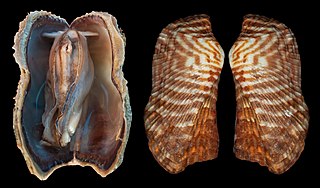
Clam is a common name for several kinds of bivalve molluscs. The word is often applied only to those that are edible and live as infauna, spending most of their lives halfway buried in the sand of the seafloor or riverbeds. Clams have two shells of equal size connected by two adductor muscles and have a powerful burrowing foot. They live in both freshwater and marine environments; in salt water they prefer to burrow down into the mud and the turbidity of the water required varies with species and location; the greatest diversity of these is in North America.

A cockle is an edible, marine bivalve mollusc. Although many small edible bivalves are loosely called cockles, true cockles are species in the family Cardiidae. True cockles live in sandy, sheltered beaches throughout the world. The distinctive rounded shells are bilaterally symmetrical, and are heart-shaped when viewed from the end. Numerous radial, evenly spaced ribs are a feature of the shell in most but not all genera.

Ark clam is the common name for a family of small to large-sized saltwater clams or marine bivalve molluscs in the family Arcidae. Ark clams vary both in shape and size. They number about 200 species worldwide.

Arca imbricata, or the mossy ark clam, is a clam in the family Arcidae. It can be found along the Atlantic coast of North America, ranging from North Carolina to the West Indies, Brazil, and Bermuda.

Arca zebra, or the turkey wing ark clam, is a bivalve mollusc in the family Arcidae, the ark clams.

Barbatia cancellaria, or the red-brown ark clam, is a clam in the family Arcidae. It can be found along the Atlantic coast of North America, ranging from Florida to the West Indies.

Barbatia candida, or the white-bearded ark clam, is a clam in the family Arcidae. It can be found along the Atlantic coast of North America, ranging from North Carolina to Texas, including the West Indies.

Barbatia domingensis, or the white miniature ark clam, is a clam in the family Arcidae. It can be found along the Atlantic coast of North America, ranging from Cape Hatteras to the West Indies and Bermuda.
Barbatia tenera, or Doc Bales' ark clam, is a clam in the family Arcidae. It can be found along the Atlantic coast of North America, ranging from southern Florida to the West Indies.

Anadara brasiliana, common name the incongruous ark clam, is a saltwater clam in the family Arcidae, the ark shells. This species is found along the Atlantic coast of North America, from North Carolina to Brazil.

Anadara floridana, also known as Anadara secticostata or the cut-ribbed ark clam, is a white colored saltwater clam with in the family Arcidae. It can be found along the Atlantic coast of North America, ranging from North Carolina to Texas, including the West Indies. Its shell grows up to 100mm, and the periostracum is dark brown. Its shape is slightly inequivalve, oblong and large. It consists of 30–38 curved radial ribs which increase in width towards the edges. These ribs are faintly incised, the groove is longitudinal.

Anadara notabilis, or the eared ark clam, is a clam in the family Arcidae. It can be found in Caribbean waters, ranging from Florida to Bermuda and Brazil.
Anadara ovalis, or the blood ark clam, is a clam in the family Arcidae. It can be found along the Atlantic coast of North America, ranging from Massachusetts to the West Indies and Brazil. It resides from the low-tide line to a depth of ten feet.

Anadara transversa, or the transverse ark clam, is a clam in the family Arcidae. It can be found along the Atlantic coast of North America, ranging from Massachusetts to Texas, including the West Indies.

Noetia ponderosa, or the ponderous ark clam, is a clam in the family Noetiidae. It can be found along the Atlantic coast of North America, ranging from Virginia to Texas.
Pitar circinatus, common name the "purple venus clam", is a species of bivalve mollusc in the family Veneridae, the venus clams. This species can be found around the coasts of the islands in the West Indies.
Macrocallista is a genus of saltwater clams, marine bivalve mollusks in the family Veneridae, the Venus clams.
Anadara baughmani, more commonly known as baughman ark or skewed arkis is a saltwater clam in the family Arcidae, which includes the ark shells. This species is found in the Caribbean Sea, Texas, Louisiana, Mississippi and Brazil. It was discovered in 1851.

Barbatia barbata is a species of ark clam, a marine bivalve mollusk in the family Arcidae, the ark clams.














